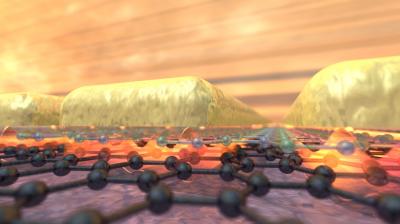Researchers at the Institute of Photonic Sciences (ICFO) in Spain, along with other members of the Graphene Flagship, have reached what they consider to be the ultimate level of light confinement - being able to confine light down to a space of one atom. This may pave the way to ultra-small optical switches, detectors and sensors.

Graphene keeps surprising us: nobody thought that confining light to the one-atom limit would be possible. It will open a completely new set of applications, such as optical communications and sensing at a scale below one nanometer, said ICREA Professor Frank Koppens at ICFO, who led the research.
At first we were looking for a new way to excite graphene plasmons. On the way, we found that the confinement was stronger than before and the additional losses minimal. So we decided to go to the one atom limit with surprising results, said David Alcaraz Iranzo, the lead author from ICFO.
By sending infra-red light through their devices, the researchers observed how the plasmons propagated in between the metal and the graphene. To reach the smallest space conceivable, they decided to reduce the gap between the metal and graphene as much as possible to see if the confinement of light remained efficient, i.e. without additional energy losses. Interestingly, they saw that even when a monolayer of hBN was used as a spacer, the plasmons were still excited, and could propagate freely while being confined to a channel of just one atom thick. They managed to switch this plasmon propagation on and off, simply by applying an electrical voltage, demonstrating the control of light guided in channels smaller than one nanometer.
This has the potential to enable new opto-electronic devices that are just one nanometer thick, such as ultra-small optical switches, detectors and sensors. Due to the paradigm shift in optical field confinement, extreme light-matter interactions can now be explored that were not accessible before. The atom-scale toolbox of two-dimensional materials has now also proven applicable for many types of new devices where both light and electrons can be controlled even down to the scale of a nanometer.
Professor Andrea C. Ferrari, Science and Technology Officer of the Graphene Flagship, and Chair of its Management Panel, added "While the flagship is driving the development of novel applications, in particular in the field of photonics and optoelectronics, we do not lose sight of fundamental research. The impressive results reported in this paper are a testimony to the relevance for cutting edge science of the Flagship work. Having reached the ultimate limit of light confinement could lead to new devices with unprecedented small dimensions.